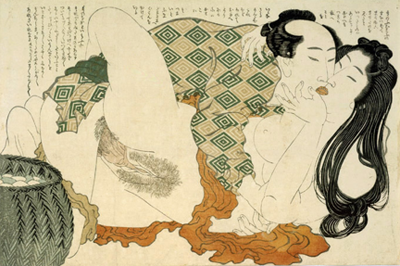Japan is the 5th largest producer of pornography in the world. In 2010, the revenue from the Japanese pornography industry was almost equal to the revenue from the video game industry, no mean feat for a country that consumes video games at a fantastic rate.
So why is it, then, that Japanese pornography is censored? Surely, all the people paying hard cash for pornography want to see the sexy bits that are covered by mosaic censoring? And if some part of the sexual act is objectionable, why not censor the whole screen instead of a tiny patch? Why is filmed Japanese pornography censored today, and what brought about the practice of censorship in the first place?
In the Beginning...
As early as the 1600s, the Japanese were creating “shunga”, pornographic wood-block prints. After being outlawed in 1722, these erotic woodcuts went underground, where they continued to be produced until they could no longer compete with the realism of photography.
Perhaps that photographic realism is what later authorities found objectionable, as these old woodcuts certainly were not marred by mosaic censoring of any kind.

Shunga: erotic wood-block print
By the start of World War II, all pornographic materials had been banned. But just after the end of the war, the influence of dirty magazines brought over by American GIs brought about a resurgence of interest pornography tailored to the Japanese market.
In the early 1960s, the market for porn in Japan had grown and movie studios were looking to get into the lucrative business. While censorship laws in Japan forbade showing genitalia, so-called “pink films” in Japan were otherwise unregulated. As long as genitals were not shown on screen, couples could be shown having sex from any other angle.
By the 1980s, adult films were making the transition from being shown in adults-only movie theatres to home viewing on VHS or Betamax tapes. The first hentai (pornographic anime) film was the “Lolita” series, released in 1984, followed three years later by Urotsukidoji, a hentai production that has the dubious honor of being the first “tentacle porn” film.
Today, you can see how prevalent adult films are in Japan by typing “Japanese+adult” in any search engine. But if you won’t have far to look before you run into a film that contains mosaic censoring.
The Mosaic
Mosaic-style censoring is nothing new. The precursor of mosaic censoring, the so-called “little black bar,” has been used in TV for decades. In the 1980s anime show “Patlabor,” the black bars were used as a comedic gag, and in the States we’ve seen the black bars used in everything from “Borat” to the music video for REM's "Pop Song 89." While we know the mosaic blur effect best in the US from shows like “Cops” where it is used to protect identities, the mosaic is more commonly used in Japan for blurring out genitalia.
Blurring out these naughty bits is serious business. In 2008, Katsumi Ono (the man in charge of censoring porn in Japan) was arrested for allowing 13,000 copies of two different adult film titles out into the marketplace that had not been adequately mosaicked.

Japanese mosaic decoder.
According to the writers at Japan Probe, “The uncensored Japanese porn that exists does so because either it was made for foreign export, or it was illegally produced/uncensored.” Gadgets like the one pictured above cost a couple hundred bucks, and can be used to “de-mosaic” the censored parts of an adult film. However, you have to use the joystick to keep the “de-mosaic” centered over the mosaic, which certainly detracts from the viewing experience. The device is good for any Japanese-made tapes or DVDs, but rendered semi-useless by the preponderance of uncensored online porn.
The Future
It seems that with each passing year, the interpretation of the section of the criminal code related to pornography censorship is enforced with less stricture. As one 2006 Japan Probe noted in 2006, “In recent years it seems that the definition of ‘injurious to public morals’ has been relaxed. Ten years ago, pubic hair was censored: now it is not. Last year, the American film Kinsey was allowed to air in Japanese theaters uncensored. The scene in which Dr. Kinsey is giving a slideshow of penis/vagina picture(s) made history as the first ever scene showing human genitalia allowed by the censors.”
Apparently, this scene was allowed because the genitals in question were shown in an educational capacity, not a titillating one. However, with the Internet as the great equalizer, today, watching uncensored porn is easy for anyone living in Japan.
But maybe the point isn’t what’s covered up, but rather what is left intact. True, the “best parts” get the mosaic treatment; something that seems contrary to the very essence of what pornography should be, at least in the minds of many people.
But perhaps storytelling is more essential to creating a watchable adult film than any exposed genitals could be. According to one expert, porn films made during the 1960s and 1970s were more than just skin flicks.

Sayuri Ichijo: Following Desire (1972)
“Although these films were categorized as porn, they should be read in wider context, as they actually gave freedom to young directors to develop their filmmaking styles as long as the films included some sexual sequences…notably Koji Wakamatsu’s disturbing Okasareta hakui (Violated Angels, 1967) and Kabe no naka no Himegoto (Affairs Within Walls, 1965), and Tatsumi Kumashiro’s biographical film on a real-life stripper Ichijo Sayuri (1972), which serve as good examples to prove that these films were not merely erotic — but could be regarded as masterpieces with considerable artistic values.”
While pornography in Japan is decades removed from this time of experimentation in Japanese cinema, it is worth noting that there are still some basic differences between Japanese pornos and their American counterparts.
You are more likely to see extended kissing scenes in Japanese porn, and while strip teases are popular in both nations’ adult films, the clothes do seem to come off more slowly in Japanese films. Sex toys also seem to be used in more Japanese heterosexual scenes than in the US, perhaps since the toys don’t need to be censored.
This too, can explain the creativity in a lot of Japanese porn. Tentacles may not be your cup of tea, but you have to admit it’s a creative and uniquely Japanese sex idea. And let’s not forget who came up with bukakke, a filmed sex-act that might have never reached such prominence if Japanese law didn’t expressly forbid showing genitalia.
The bottom line? Just because Japanese porn might be mosaic-laden doesn’t mean that it isn’t worth watching.